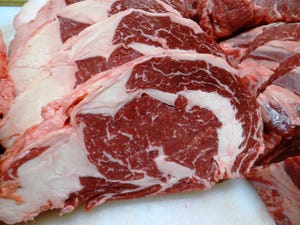More Placements – Not More Cattle
As expected by most analysts, Friday’s Cattle on Feed report revealed a staggering increase in May 1 placement number (+23%) compared
June 20, 2010

As expected by most analysts, Friday’s Cattle on Feed report revealed a staggering increase in May 1 placement number (+23%) compared to a year earlier. But, Derrell Peel, Oklahoma State University (OSU) Extension livestock marketing specialist, points out that has to do with market timing, not an increase in cattle numbers.
“There are several reasons why May placements, like April, showed an increase after many months of decreases. That is, in fact, one of the reason for larger placements,” Peel wrote in his OSU Cow-Calf Corner commentary. “Feedlots have been reducing feedlot inventories for many months in the face of economic losses and were anxious to rebuild feedlot inventories following a couple of months of better closeouts.
“The wheat market also played a role as the deteriorating wheat price this spring encouraged late purchases of wheat stockers and additional wheat grazeout that carried cattle into May. Moreover, the strengthening of feeder prices this spring encouraged producers to hold stockers and retained calves into May. After two months of larger placements, we will likely see slower placements until summer grazing cattle are available in the fall.”
Peel adds that, compared to the five-year average, May 1 placements are down 4%.
Both lower cost of gain and beef prices higher than most expected heading into June encouraged more placement. According to the Livestock Marketing Information Center (LMIC), although cost of gains (COG) for April steer closeouts were $3-$5/cwt. more than those of last fall, projected COG for May-placed cattle, if realized, would be the lowest reported for the month of May since 2006. That’s based on April’s Kansas State University monthly Focus on Feedlots Survey.
“Feeding COG continued to decline for steers and heifers sold in April as corn and hay prices have softened to levels not seen since before 2007,” say LMIC analysts. “For the month of April, the average COG for steers was $75.84/cwt., over $9/cwt. less than in 2009, while COG for heifers at $78.27/cwt. was $11/cwt. lower.”
Last week, feeder cattle and calves sold unevenly steady, with most areas reporting narrow trend ranges from $2 lower to $2 higher, according to the Agricultural Marketing Service (AMS). Fed cattle sold $1-$2 lower at mostly $91.
“Friday’s cattle-on-feed report appeared slightly bearish, with May placements a little larger than expected and May marketings slightly less than predicted, at 123.4% and 95.7% respectively,” say AMS analysts. “June 1 on-feed totals were absolutely nailed by industry analysts at 100.8% of the same time last year. Evidently, there were more wheat cattle that stayed on pasture longer than predicted, despite the high price levels that were coaxing them to market.”
After next week, auction receipts for feeder cattle and calves will be lighter or the next two weeks due to the July 4th holiday and how it falls this year.
“We will continue to see seasonal pressure on fed prices until Labor Day with recovery expected in the fourth quarter,” Peel says. “Just how low summer prices will go and how much recovery can be expected in the fourth quarter depends on demand.”
The summary below reflects the week ended June 18 for Medium and Large 1 – 500- to 550-lb., 600- to 650-lb. (calves), and 700- to 750-lb. feeder heifers and steers (unless otherwise noted). The list is arranged in descending order by auction volume and represents sales reported in the weekly USDA National Feeder and Stocker Cattle Summary:
Summary Table |
State |
Calf Weight |
MO |
OK |
TX |
KY* |
AL |
AR |
FL* |
Carolinas* |
TN* |
SD |
GA*(***) |
LA* |
MS* |
NM |
KS |
WY |
VA |
NE |
* Plus # 2
** None reported of the same quality at this weight or near weight
(***) Steers and bulls
(?) As reported, but questionable
NDNo Description
1500-600 lbs.
2550-600 lbs.
3600-700 lbs.
4650-700 lbs.
5700-800 lbs.
6750-800 lbs.
7800-850 lbs.
8850-900 lbs.
You May Also Like



